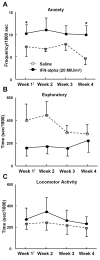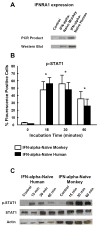Effects of interferon-alpha on rhesus monkeys: a nonhuman primate model of cytokine-induced depression
- PMID: 17678633
- PMCID: PMC2149847
- DOI: 10.1016/j.biopsych.2007.05.026
Effects of interferon-alpha on rhesus monkeys: a nonhuman primate model of cytokine-induced depression
Abstract
Background: Interferon (IFN)-alpha is an innate immune cytokine that causes high rates of depression in humans and therefore has been used to study the impact of cytokines on the brain and behavior. To establish a nonhuman primate model of cytokine-induced depression, we examined the effects of IFN-alpha on rhesus monkeys.
Methods: Eight rhesus monkeys were administered recombinant human (rHu)-IFN-alpha (20 MIU/m(2)) or saline for 4 weeks in counterbalanced fashion, and videotaped behavior, as well as plasma and cerebrospinal fluid (CSF), were obtained at regular intervals to assess behavioral, neuroendocrine, immune, and neurotransmitter parameters. Additionally, expression and activity of IFN-alpha/beta receptors in monkey peripheral blood mononuclear cells (PBMCs) were assessed.
Results: Compared with saline treatment, IFN-alpha administration was associated with persistent increases in anxiety-like behaviors and decreases in environmental exploration. In addition, IFN-alpha induced significant increases in plasma concentrations of corticotropin (ACTH), cortisol, and interleukin-6 that tended to diminish after chronic administration, especially in dominant animals. Interestingly, in three animals, depressive-like, huddling behavior was observed. Monkeys that displayed huddling behavior exhibited significantly higher plasma concentrations of ACTH and lower CSF concentrations of the dopamine metabolite homovanillic acid. Rhesus monkey PBMCs were found to express mRNA and protein for the IFN-alpha/beta receptor. Moreover, treatment of PBMCs with rHu-IFN-alpha led to induction of STAT1, one of the primary IFN-alpha-induced signaling molecules.
Conclusions: IFN-alpha evoked behavioral, neuroendocrine, and immune responses in rhesus monkeys that are similar to humans. Moreover, alterations in hypothalamic-pituitary-adrenal axis responses and dopamine metabolism may contribute to IFN-alpha-induced depressive-like huddling behavior.
Figures







References
-
- Kirkwood JM, Ernstoff MS. Role of interferons in the therapy of melanoma. J Invest Dermatol. 1990;95:180S–184S. - PubMed
-
- Saracco G, Olivero A, Ciancio A, Carenzi S, Rizzetto M. Therapy of chronic hepatitis C: a critical review. Curr Drug Targets Infect Disord. 2003;3:25–32. - PubMed
-
- Hauser P, Khosla J, Aurora H, Laurin J, Kling MA, Hill J, et al. A prospective study of the incidence and open-label treatment of interferon-induced major depressive disorder in patients with hepatitis C. Mol Psychiatry. 2002;7:942–947. - PubMed
-
- Kraus MR, Schafer A, Faller H, Csef H, Scheurlen M. Psychiatric symptoms in patients with chronic hepatitis C receiving interferon alfa-2b therapy. J Clin Psychiatry. 2003;64:708–714. - PubMed
-
- Musselman DL, Lawson DH, Gumnick JF, Manatunga AK, Penna S, Goodkin RS, et al. Paroxetine for the prevention of depression induced by high-dose interferon alfa. N Engl J Med. 2001;344:961–966. - PubMed
Publication types
MeSH terms
Substances
Grants and funding
LinkOut - more resources
Full Text Sources
Medical
Research Materials
Miscellaneous

